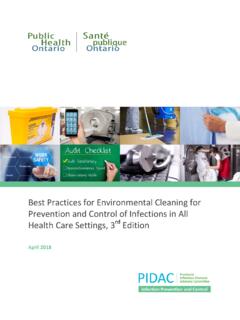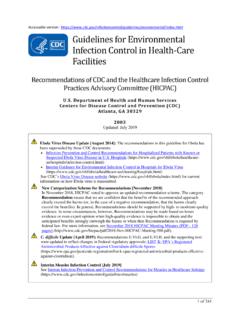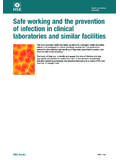Transcription of INFECTION CONTROL RISK ASSESSMENT - Idaho Health …
1 7/6/2021. INFECTION CONTROL . RISK ASSESSMENT . JONATHAN TETER, MS, CIC, EMT. DIRECTOR OF EPIDEMIOLOGY AND ANALYTICS. RB Health PARTNERS, INC. 2021 RB Health Partners, Inc. 1. Objectives 2. 1. 7/6/2021. Objectives Define Define INFECTION CONTROL risk ASSESSMENT ;. Describe Describe the process for completing an INFECTION CONTROL risk ASSESSMENT ;. Complete Complete an INFECTION CONTROL risk ASSESSMENT ; and Discuss process for developing objectives for your INFECTION prevention and Discuss CONTROL plan. 3. Risk Assessments 4. 2. 7/6/2021. What is a Risk ASSESSMENT ? : A risk ASSESSMENT is a process to identify potential hazards and analyze what could happen if a hazard occurs.. Used in many fields including emergency management, business, INFECTION CONTROL , occupational safety, engineering, etc. Can also be called or part of hazard analysis, gap analysis, or other systematic safety protocols 5.
2 Risk Assessments Proactive process May be used for strategic planning May be part of business impact analysis Provide direction on priorities Assist with decision making for resource allocation Identify potential for harm and or opportunities to reduce risk Evaluate if precautions have been taken to prevent harm 6. 3. 7/6/2021. Types of IPC Risk Assessments 7. Annual Risk Assessments INFECTION prevention and CONTROL program TB. Water Management IPC Umbrella As needed Risk Assessments construction New Service Practice change For policy & procedure development 7. INFECTION CONTROL The results of the facility ASSESSMENT must be used, in part, to establish and update the IPCP, its policies and/or protocols to include a system for preventing, identifying, reporting, investigating, and controlling infections and communicable diseases for residents, staff, and visitors. NOTE: A community-based risk ASSESSMENT should include review for risk of infections ( , multidrug- resistant organisms- MDROs) and communicable diseases such as tuberculosis and influenza.
3 8. 4. 7/6/2021. INFECTION CONTROL Risk ASSESSMENT 9. (ICRA). Evaluation tool for INFECTION prevention and CONTROL program Drive decision making for INFECTION prevention and CONTROL (strategic) plan Goals Measurable objectives Quantify threats to prioritize action plans Identify focus areas 9. CDC Risk ASSESSMENT Tool - This specific risk ASSESSMENT is not required for compliance. 10. 10. 5. 7/6/2021. RB Health Partner Tool This specific risk ASSESSMENT is not required for compliance. 11. 11. 12 INFECTION CONTROL Risk ASSESSMENT Annual Risk ASSESSMENT Basics 12. 6. 7/6/2021. What? Process to evaluate potential risk for acquiring and Process transmitting infections in the facility and to/from the community Threats Identify threats to resident's Health Opportunities Identify opportunities for improvement in practice and policy Gaps Identify gaps in practices 13. Why? Foundation of INFECTION Use to establish goals and prevention and CONTROL objectives plan Identify focus areas for What to track and why surveillance Prioritize INFECTION prevention and CONTROL activities/initiatives 14.
4 7. 7/6/2021. How? Identify the hazards Created with multi- Identify and use risk (brainstorming disciplinary team ASSESSMENT tool potential hazards). Develop objectives and strategies to Score Review prioritized address that are hazards/threats list threats incorporated into IPCP. Monitor progress 15. 16 Risk Score Qualitative Scoring for Risk Assessments 16. 8. 7/6/2021. Four Basic Categories Probability of Occurrence Severity Current Capacity Training/Education Program Other tools may vary categories slightly CDC tool uses Impact rather than training/education and Readiness . rather than Capacity 17. Probability of Occurrence Risk Score Has this Is this likely happened in to occur in the past? the future? How well do How often staff adhere does event to policy occur or is it and/or likely to practice? occur? 18. 9. 7/6/2021. Scoring Probability of occurrence (4). (1) (2) (3) Almost Frequently always or Rarely Sometimes ongoing event 19.
5 Severity Rating Risk Score What is the impact to Will event lead to To what extent will the patient/resident? significant morbidity? the patient/resident Loss of life or loss of Loss of quality of life? experience harm? function? Are there financial, What does the What is the impact to legal, or regulatory literature tell us the facility? issues associated with about the event? the event? 20. 10. 7/6/2021. Scoring Severity rating (1) (4). (2) (3). Minimal Catastrophic Some harm Major harm harm harm 21. Current Capacity Risk Score DO YOU HAVE ARE THE NECESSARY RESOURCES. POLICIES/PROCEDURES IN ( SUPPLIES, TECHNOLOGY, ETC.). AVAILABLE TO ADDRESS EVENT? PLACE TO ADDRESS EVENT? 22. 11. 7/6/2021. Scoring Current capacity (2). (1) Few gaps - (3). (4). No gaps - Have Have most Some gaps - Major gaps in policies and policies and/or Gaps in policies and/or sufficient most policies and/or lack resources resources resources resources necessary 23.
6 Training Program Do you have training materials or does training need to be developed? Have staff been trained? Are staff trained annually and as needed? Have competencies been assessed and verified? 24. 12. 7/6/2021. Scoring Training Program (1). No gaps - All (2). (3) (4). staff have been Few gaps - Some gaps in Major gaps in trained (based Most staff have training and/or training and/or on job been trained competency competency function) and and validated validation validation validated competencies competencies 25. The Process Present Provide Solicit Score events Rank Higher tool to instructions feedback ( , generate events score =. multi- on how tool and consensus on each score for from higher disciplinary will be used update highest priority probability, team tool severity, and score to Modify or add current lowest events as capacity and needed performance). score 26.
7 13. 7/6/2021. Methods for Completion Group Discussion Rank/Voting Convene a meeting of Each team member multi-disciplinary group completes separately Discuss each item and Scores are calculated and come to a consensus on a group score created each score from the responses Complete tool and rank Send to group as results and update tool 27. Pros and Cons Group Discussion Rank/Voting Group can discuss issues Good if team cannot all at once meet together Identifies potential gaps Can avoid lengthy or new risks meetings and discussions Can create lengthy Does not leave much discussion room for discussion Requires good attendance Completion bias 28. 14. 7/6/2021. Next Steps Use results to update Develop measurable INFECTION prevention objectives to address and CONTROL plan top priorities Identify what data needs to be collected Develop strategies to to determine if achieve objectives objective is met and how the data will be collected Develop tools to Identify how and support data what feedback will be collection and provided to staff reporting 29.
8 30 INFECTION prevention and CONTROL Plan Using the Risk ASSESSMENT in Planning 30. 15. 7/6/2021. INFECTION prevention and CONTROL Plan Serves as foundation of INFECTION prevention and CONTROL program Updated annually based on results of risk ASSESSMENT , surveillance data, and other outcomes from the previous year Used to evaluate effectiveness of IPC program 31. Components of IPC Plan 32. Introduction Employee Health Purpose Goals and Objectives Authority Reporting and Scope of Program Evaluation Surveillance Antibiotic Outbreaks Stewardship 32. 16. 7/6/2021. Objectives 33. Based on risk ASSESSMENT Must complete and update annually Priorities/focus areas identified by the INFECTION CONTROL risk ASSESSMENT need to be reflected in INFECTION prevention and CONTROL plan Include copy of risk ASSESSMENT as an appendix to the INFECTION prevention and CONTROL plan 33. Example Objective Process Measure By May 31, 2022 achieve 95% compliance with performing hand hygiene when entering and exiting a resident room and to sustain compliance through the end of the year.
9 Strategies - Installation of additional alcohol-based hand rub dispensers. Monitor compliance by job role, summarize data, and provide feedback to staff on compliance monthly. Coaching to staff is provided as needed. Competition between staff by job role will be used to help foster behavior change. Positive reward ( recognition, gift card) will be given to the best performing staff by job role each month. 34. 17. 7/6/2021. Example Objective Outcome Measure By December 31, 2021, decrease C. difficile INFECTION rate to <. resident days. Strategies Increase access to bleach wipes, immediately implement precautions upon first suspicion of C. difficile INFECTION , monitor compliance with precautions, and coordinate with antibiotic stewardship committee for targets to reduce inappropriate antibiotic use (See antibiotic stewardship plan for more information.). 35. QAPI Report 36. Objective.
10 95%. compliance with hand hygiene 36. 18. 7/6/2021. QAPI Report 37. Objective - Decrease C. C. difficile INFECTION Rates 2021. difficile INFECTION rate 3 3 3 3. to < 1000 resident days 2 2 2. 1 1 1 1 1 1 1 1 1 1 1 1 1. 0. Jan Feb March April May June July Aug Sept Oct Nov Dec Goal INFECTION rate 37. Antibiotic Stewardship Plan 38. Minimum of one process measure Minimum of one outcome measure Define what is tracked and how it is tracked o Do not have to track all antibiotic starts on a line list! o Target what you are tracking to align with measurable objectives and why you choose those targets Based on point prevalence study Based on review of inappropriate antibiotic starts Based on antibiogram Consider excluding topical antimicrobials May include antibiogram in appendix to plan 38. 19. 7/6/2021. How To Create Plan? 39. Establish committee o INFECTION prevention and CONTROL committee o May include members of QAPI committee o May include ad hoc participation from front line staff for development of strategies to achieve objectives Review priority areas identified by risk ASSESSMENT Review analysis of surveillance data Determine goals and objectives 39.






